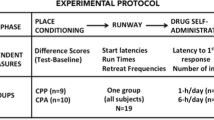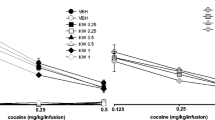Abstract
Amphetamine has rewarding properties in some behavioral paradigms, such as self-administration and conditioned place preference (CPP), but an aversive component is also apparent when the drug is tested with the conditioned taste aversion (CTA) paradigm. The persent study was an attempt to determine the neuroanatomical substrates of the drug's rewarding and aversive effects. Previous evidence suggested that amphetamine's stimulation of activity in dopaminergic synapses is critical for both effects. Amphetamine was therefore micro-injected bilaterally (10 μg/0.5 μl per side) into six different dopaminergic sites, each in a different group of animals: the medial prefrontal cortex, nucleus accumbens, anteromedial caudate nucleus, lateroventral caudate nucleus, amygdala, and the region subjacent to the area postrema (AP region). The effects of these injections in both the taste and place conditioning paradigms were examined in separate experiments. Of the six sites, a significant CPP was observed only with accumbens injections and a significant CTA was observed only with AP region injections. It was concluded that the accumbens plays a primary role in mediating the rewarding effects of amphetamine and that the AP region plays a primary role in mediating the CTA. This constitutes an anatomical disassociation of amphetamine's rewarding and aversive effects. The differential associative bias of place-reward and taste-aversion learning apparent in the results is discussed.
Similar content being viewed by others
References
Aulisi EF, Hoebel BG (1983) Rewarding effects of amphetamine and cocaine in the nucleus accumbens and block by flupenthixol. Soc Neurosci Abstr 9:121
Berger BD, Wise CD, Stein L (1972) Area postrema damage and bait shyness. J Comp Physiol Psychol 82:475–479
Carey RJ (1978) A comparison of the food intake suppression produced by giving amphetamine as an aversion treatment versus as an anorexic treatment. Psychopharmacology 56:45–48
Carr GD, Whilte NM (1983) Conditioned place preference from intra-accumbens but not intra-caudate amphetamine injections. Life Sci 33:2551–2557
Coil JD, Rogers RC, Garcia J, Novin D (1978) Conditioned taste aversions: vagal and circulatory mediation of the toxic unconditioned stimulus. Behav Biol 24:509–519
Fallon JH, Koziell DA, Moore RY (1978) Catecholamine innervation of the basal forebrain: II. Amygdala and entorhinal cortex. J Comp Neurol 180:509–532
Fallon JH, Moore RY (1978a) Catecholamine innervation of the basal forebrain: III. Olfactory bulb, anterior olfactory nuclei, olfactory tubercle and piriform cortex. J Comp Neurol 180:533–544
Fallon JH, Moore RY (1978b) Catecholamine innervation of the basal forebrain: IV. Topography of the dopamine projection to the basal forebrain and neostriatum. J Comp Neurol 180:545–580
Garcia J, Ervin FR (1968) Gustatory-visceral and telereceptor-cutaneous conditioning — adaptation in internal and external milieus. Comm Behav Biol A1:389–415
Goudie AJ (1979) Aversive stimulus properties of drugs. Neuropharmacology 13:971–979
Grupp LA (1977) Effects of pimozide on the acquisition, maintenance, and extinction of an amphetamine-induced taste aversion. Psychopharmacology 53:235–242
Grupp LA, Linseman MA, Cappell H (1976) Effects of amygdala lesions on taste aversions produced by amphetamine and LiCl. Pharmacol Biochem Behav 4:541–544
Gunne LM, Anggard E, Jonsson LE (1972) Clinical trials with amphetamine-blocking drugs. Psychiatria Neurologia Neurochirurgia 75:225–226
Hoebel BG, Monaco AP, Hernandez L, Aulisi EF, Stanley BG, Lenard L (1983) Self-injection of amphetamine directly into the brain. Psychopharmacology 81:158–163
Holman EW (1975) Immediate and delayed reinforcers for flavour preferences in rats. Learn Motiv 6:91–100
Kalai M, Fuxe K, Goldstein M, Harfstrand A, Agnati LF, Coyle JT (1984) Evidence for the existence of putative dopamine-, adrenaline-and noradrenalin-containing vagal motor neurons in the brainstem of the rat. Neurosci Lett 50:57–62
Kalant OJ (1966) The amphetamines: Toxicity and addiction. University of Toronto Press, Toronto
Kliner DJ, Pickens R (1982) Indicated preference for drugs of abuse. Int J Addict 17:543–547
LeMagnen J (1969) Peripheral and systemic actions of food in caloric regulation of intake. Ann New York Acad Sci USA 157:1126–1157
Levitt P, Moore RY (1979) Origin and organization of brainstem catecholamine innervation in the rat. J Comp Neurol 186:505–528
Lorden JF, Callahan M, Dawson R (1980) Depletion of central catecholamines alters amphetamine- and fenfluramine-induced taste aversions in the rat. J Comp Physiol Psychol 90:665–679
Lyness WY, Friedle NM, Moore KE (1979) Destruction of dopaminergic nerve terminals in nucleus accumbens: Effect on d-amphetamine self-administration. Pharmacol Biochem Behav 11:553–556
Morest DK (1967) Experimental study of the projections of the nucleus of the tractus solitarius and the area postrema in the cat. J Comp Neurol 130:277–300
Pellegrino LJ, Pellegrino AS, Cushman AJ (1979) Atlas of the rat brain. Plenum, New York
Pickens R, Harris WC (1968) Self-administration of d-amphetamine by rats. Psychopharmacologia 12:158–163
Pharmaceutical Society of Britain (1977) Martindale: The extra pharmacopoeia. The Pharmaceutical Press, London
Reicher MA, Holman EW (1977) Location preference and flavour aversion reinforced by amphetamine in rats. Anim Learn Behav 5:343–346
Schuster CR, Thompson T (1969) Self-administration of and behavioral dependance on drugs. Ann Rev Pharmacol 7:483–502
Spyraki C, Fibiger HC, Phillips AG (1982) Dopaminergic substrates of amphetamine-induced place preference conditioning. Brain Res 253:185–193
Stefanini E, Clement-Cormier Y (1981) Detection of dopamine receptors in the area postrema. Eur J Pharmacol 74:257–260
Stolerman IP, D'Mello GD (1978) Amphetamine-induced hypodipsia and its implications for conditioned taste aversion in rats. Pharmacol Biochem Behav 8:333–338
Sumal KK, Blessing WW, Joh TH, Reis DJ, Pickel VM (1983) Synaptic interaction of vagal afferents and catecholaminergic neurons in the rat nucleus tractus solitarius. Brain Res 277:31–40
Wagner GC, Foltin RW, Seiden LS, Schuster CR (1981) Dopamine depletion by 6-hydroxydopamine prevents conditioned taste aversion induced by methylamphetamine but not by lithium chloride. Pharmacol Biochem Behav 14:85–88
White NM, Carr GD (1985) The conditioned place preference is affected by two different reinforcement processes. Physiol Behav (in press)
White NM, Messier C, Carr GD (1985) Operationalizing and measuring the organizing influence of drugs on behavior. In: Bozarth MA (ed) Methods of assessing the reinforcing influence of drugs on behavior. Haer Institute, Brunswick, ME
Yokel RA, Wise RA (1975) Increased lever pressing for amphetamine after pimozide in rats: Implications for a dopamine theory of reward. Science 187:547–549
Author information
Authors and Affiliations
Additional information
Offprint requests to: N.M. White
Rights and permissions
About this article
Cite this article
Carr, G.D., White, N.M. Anatomical disassociation of amphetamine's rewarding and aversive effects: An intracranial microinjection study. Psychopharmacology 89, 340–346 (1986). https://doi.org/10.1007/BF00174372
Received:
Revised:
Issue Date:
DOI: https://doi.org/10.1007/BF00174372




